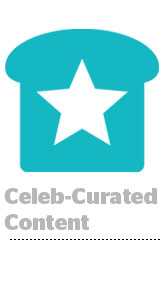 Celebrities typically make money from their digital presences through influencer marketing, though some have become digital publishers. Consider Kim Kardashian’s app, Gwyneth Paltrow’s Goop, Lena Dunham’s Lenny, Derek Jeter’s The Player’s Tribune and LaurenConrad.com.
Celebrities typically make money from their digital presences through influencer marketing, though some have become digital publishers. Consider Kim Kardashian’s app, Gwyneth Paltrow’s Goop, Lena Dunham’s Lenny, Derek Jeter’s The Player’s Tribune and LaurenConrad.com.
While many of those sites are custom-built, new companies like DWNLD and Fanbread are cropping up and offering turnkey solutions to help celebrities become publishers.
Two-year-old FanBread has signed up 30 celebrities on its platform, including Vanessa Hudgens, Ashley Benson and Lisa Rinna. Each celebrity has her own URL and owned-and-operated site.
A team of freelancers writes articles approved by the celebs. Then the stars post links to those articles on their social media profiles, driving traffic to a site that already has robust programmatic pipes built in to maximize revenue. FanBread splits revenue 50-50 with celebrities.
FanBread itself is heavily reliant on stars’ Facebook presences to bring in traffic. But so far it’s been a mutually beneficial relationship, according to company founder and CEO Karl House. Most celebrities see dramatic increases in followers as they post relevant content to fans, who in turn share those articles and broaden their reach.
But when celebrities can earn tens to hundreds of thousands of dollars simply by posting references to brands on Twitter, Facebook or Instagram as an influencer, why go through the effort of being a publisher?
According to House, influencer marketing campaigns require too much “heavy lifting” on the part of the advertiser, from selecting the celebrity to creating content.
And influencer marketing budget is not a core part of a media plan. “A brand can’t deploy $100 million in media in influencer marketing,” he said. “It’s 3% to 5% a year, as the cherry on top.”
Ultimately, the celebs-as-publisher model is more scalable because it taps into the core line items on a media plan: banner ads and scalable native formats.
While banner ads are on the decline, House doesn’t see them going away soon. He also said the format will perform better in the context of Facebook Instant Articles (which FanBread will join in mid-April). Because publishers show fewer ads on those articles, each ad will become more valuable, House said.
House said Instant Articles might also shake up a previously reliable revenue stream: celebrities who get money from traffic they drive to publishers. As AdExchanger reported last year, celebrities like George Takei and Lil Wayne post articles in exchange for a cut of the revenue from resulting traffic, serving as mini-Outbrains or Facebook ads.
House hopes that if this model founders, those celebrities will decide to be publishers themselves, instead of just distributors of content.
FanBread also is betting it will expand from licensing its platform to long-tail influencers. For FanBread, that means influencers with fewer than 1 million followers, whom the company hasn’t previously worked with because they’re too small to justify the effort. But many of these smaller influencers are eager to join FanBread because they see it as a “growth hack,” House said, or a clear way to grow their follower base.
That said, celebrities who are already familiar faces have a leg up over noncelebrity influencers who need to build from the ground up. House is banking that celebs just need to activate that brand equity in the digital world.
“If you are a traditional magazine publisher,” he said, “I would be more concerned about celebrities as publishers than I would with [other social-driven digital media startups] like a LittleThings or Diply.”













